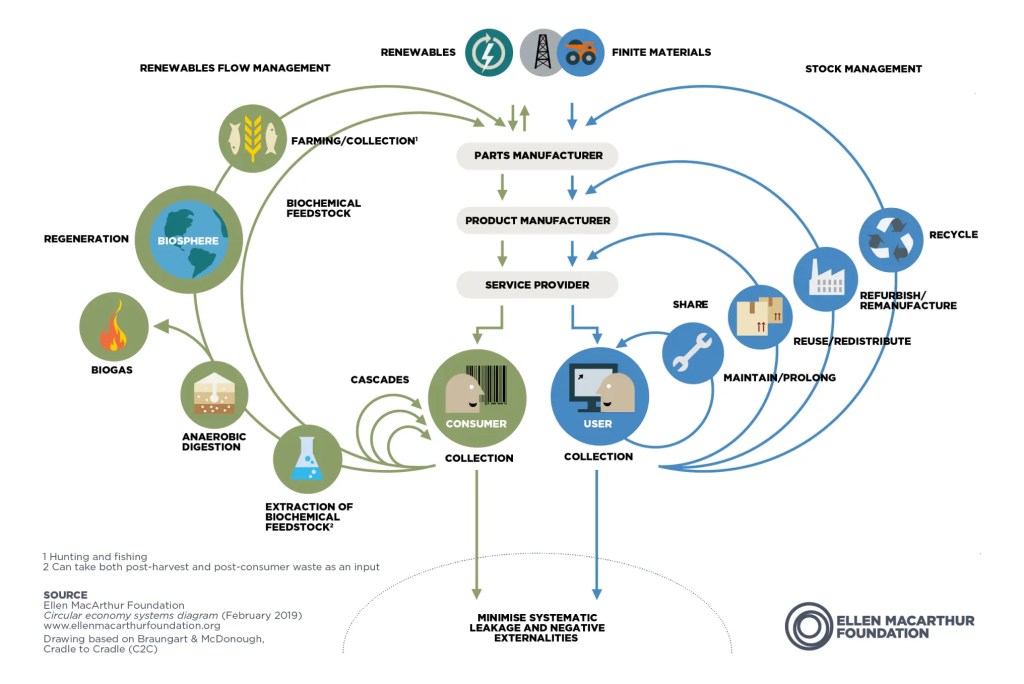What is a Circular Economy?
A circular economy is a regenerative economic model focused on minimizing waste, reusing materials, and regenerating natural systems to create a closed-loop system that reduces environmental impact. Unlike the traditional linear economy, which follows a “take, make, waste” approach, the circular economy promotes resource efficiency by keeping products and materials in use for as long as possible.

Ellen MacArthur Foundation’s Butterfly Diagram: visualizing the circular economy
Core Principles of the Circular Economy
To understand the core principles of the circular economy, we must first understand the state of our current global economic system. Today’s “take-make-waste” approach is both resource-intensive and unsustainable, leading to environmental degradation, pollution, economic and biodiversity loss and more. The Ellen MacArthur Foundation, widely regarded as a pioneering organization in this field, has established three design-driven core principles of the circular economy:

Eliminate Waste and Pollution
In our current economic model, we take raw materials from the Earth, we make products from them, and eventually we throw them away. This system is unsustainable in the long term, as the resources on our planet are finite.

Circular Products and Materials
A key strategy in the transition of the economy from linear to circular is ensuring materials and products stay at their highest and best use indefinitely. This design opportunity limits waste and helps maintain the intrinsic value of product and materials.

Regenerate Nature
By moving from a take-make-waste linear economy to a circular economy, we support natural processes and leave more room for nature to thrive.
Why the Circular Economy Matters
The circular economy is a crucial solution to the escalating global demand for resources and the negative environmental impacts of traditional, linear consumption models. With material consumption up by over 65% in the past two decades and expected to triple by 2050, our current practices are unsustainable. According to the United Nations, if current trends continue, we would need the resources of three Earths by mid-century. Transitioning to circularity is also a climate imperative as circular business models use less energy and emit less carbon than linear models in most cases.The circular economy offers a sustainable solution by focusing on minimizing waste, reusing materials and creating innovative closed-loop systems across all industries.
Examples of the Circular Economy in Action
To inspire and illustrate the power of circular solutions in action, Trellis Group reports on private and public companies, NGOs, startups and governments that are transforming their value chains and using nature as a model for circularity. These organizations are rethinking product design, innovating new value chains, adopting practices and policies that regenerate resources and implementing solutions that close the loop on the materials they put out into the world.
Explore the following articles to see how organizations are successfully implementing circular strategies and driving meaningful change:
How Circularity Accelerates the Circular Economy
As we confront the complex challenges of building a circular economy, collaboration with industry peers and learning from leaders is essential to advancing the progress your company, and the world, needs.
Circularity (June 23 – June, 26 2026, in San Francisco, CA) is the premier gathering for professionals committed to transforming our economy by advancing solutions for the circular economy. With the goal of building a just, resilient economy within planetary boundaries, Circularity unites industry leaders, innovators, and policymakers to reshape how we make, sell, and circulate products.
Next year’s Circularity is part of Trellis Impact 26 (site coming soon), giving attendees access to four leading events taking place together — Circularity, VERGE, Bloom and GreenFin. Trellis Impact 26 bridges climate, nature, and circular economy strategies with sustainable finance, empowering professionals to accelerate innovative solutions to our planet’s biggest challenges.
Be part of the circular future
Don’t miss the chance to accelerate your journey toward a circular economy—register now for Circularity and help build a just, resilient future.




